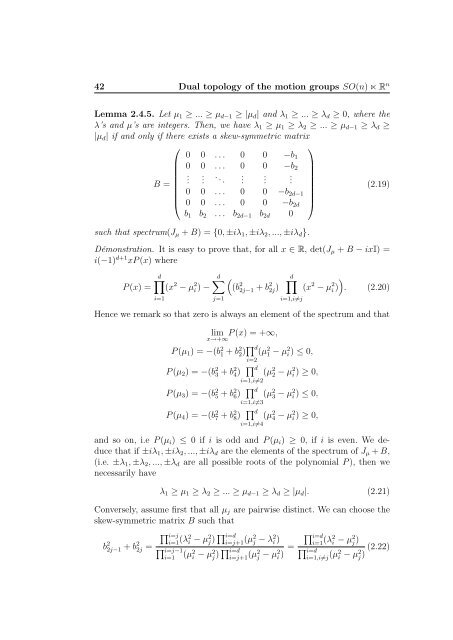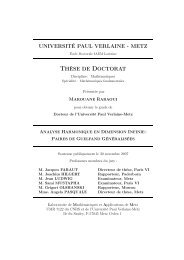Create successful ePaper yourself
Turn your PDF publications into a flip-book with our unique Google optimized e-Paper software.
42 Dual topology of the motion groups SO(n) ⋉ R n<br />
Lemma 2.4.5. Let µ1 ≥ ... ≥ µd−1 ≥ |µd| and λ1 ≥ ... ≥ λd ≥ 0, where the<br />
λ’s and µ’s are integers. Then, we have λ1 ≥ µ1 ≥ λ2 ≥ ... ≥ µd−1 ≥ λd ≥<br />
|µd| if and only if there exists a skew-symmetric matrix<br />
⎛<br />
⎞<br />
0 0 . . . 0 0 −b1<br />
⎜ 0 0 . . . 0 0 −b2<br />
⎟<br />
⎜<br />
..<br />
⎟<br />
. . . . . . ⎟<br />
B = ⎜<br />
⎝<br />
0 0 . . . 0 0 −b2d−1<br />
0 0 . . . 0 0 −b2d<br />
b1 b2 . . . b2d−1 b2d 0<br />
such that spectrum(Jµ + B) = {0, ±iλ1, ±iλ2, ..., ±iλd}.<br />
⎟<br />
⎠<br />
(2.19)<br />
Démonstration. It is easy to prove that, for all x ∈ R, <strong>de</strong>t(Jµ + B − ixI) =<br />
i(−1) d+1 xP (x) where<br />
P (x) =<br />
d�<br />
(x 2 − µ 2 i ) −<br />
i=1<br />
d�<br />
j=1<br />
�<br />
(b 2 2j−1 + b 2 2j)<br />
d�<br />
i=1,i�=j<br />
(x 2 − µ 2 �<br />
i ) . (2.20)<br />
Hence we remark so that zero is always an element of the spectrum and that<br />
lim P (x) = +∞,<br />
x→+∞<br />
P (µ1) = −(b2 1 + b2 2) �d (µ 2 1 − µ 2 i ) ≤ 0,<br />
i=2<br />
P (µ2) = −(b 2 3 + b 2 4) � d<br />
i=1,i�=2<br />
P (µ3) = −(b 2 5 + b 2 6) � d<br />
i=1,i�=3<br />
P (µ4) = −(b 2 7 + b 2 8) � d<br />
i=1,i�=4<br />
(µ 2 2 − µ 2 i ) ≥ 0,<br />
(µ 2 3 − µ 2 i ) ≤ 0,<br />
(µ 2 4 − µ 2 i ) ≥ 0,<br />
and so on, i.e P (µi) ≤ 0 if i is odd and P (µi) ≥ 0, if i is even. We <strong>de</strong>duce<br />
that if ±iλ1, ±iλ2, ..., ±iλd are the elements of the spectrum of Jµ + B,<br />
(i.e. ±λ1, ±λ2, ..., ±λd are all possible roots of the polynomial P ), then we<br />
necessarily have<br />
λ1 ≥ µ1 ≥ λ2 ≥ ... ≥ µd−1 ≥ λd ≥ |µd|. (2.21)<br />
Conversely, assume first that all µj are pairwise distinct. We can choose the<br />
skew-symmetric matrix B such that<br />
b 2 2j−1 + b 2 �i=j i=1<br />
2j =<br />
(λ2i − µ 2 j) �i=d i=j+1 (µ2j − λ2 i )<br />
�i=j−1 i=1 (µ 2 i − µ2j ) �i=d i=j+1 (µ2j − µ2 �i=d i=1<br />
=<br />
i ) (λ2i − µ 2 j)<br />
�i=d i=1,i�=j (µ2i − µ2 (2.22)<br />
j )





